

The Bipartisan Gun Control Bill
source link: https://medium.com/armedwithreason/the-bipartisan-gun-control-bill-fa8fbfa9ff0a
Go to the source link to view the article. You can view the picture content, updated content and better typesetting reading experience. If the link is broken, please click the button below to view the snapshot at that time.
The Bipartisan Gun Control Bill
What’s in the Bipartisan Safer Communities Act and what does it mean for gun safety?
The Bipartisan Gun Control Bill of 2022, officially titled, “The Bipartisan Safer Communities Act,” passed in the House by a vote of 234–193, with 14 Republicans joining all the Democrats. The Senate voted 65–33, with 15 Republicans voting with Democrats. President Biden signed the Bill which some hailed as “the most significant gun control bill in three decades.” After nearly 30 years of inaction and hundreds of thousands of Americans dead from gun violence, that’s telling.
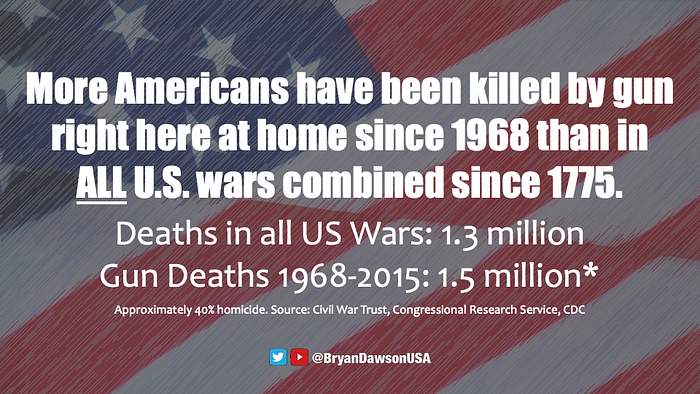
So, what’s in this bill? What’s the good and bad? How would I rate it? Read on.
An Astonishing Death Toll
Before we break down the bill, let’s first put things into context and take a look at the staggering death toll from gun violence in America:
“Every day, more than 110 Americans are killed with guns and more than 200 are shot and wounded.” — Everytown
The United States is unique among developed countries in its murder rate. More Americans have been killed by gun right here at home since 1968 than in ALL U.S. wars combined since 1775.
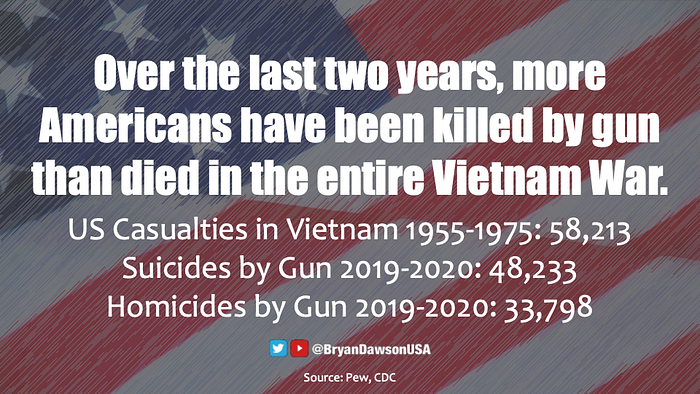
More Americans have died by gun in the last two years than in the entire Vietnam War.
Since 1968, over 1.5 million Americans died by gun, over 40% by homicide. The U.S. sees an average of over 40,000 gun-related deaths each year. This is a staggering number considering the combined death toll from all U.S. wars since 1775 is 1.3 million. In just the last two years (and every two-year period prior), more Americans have died by gun violence than died in the entire 20-year Vietnam War.
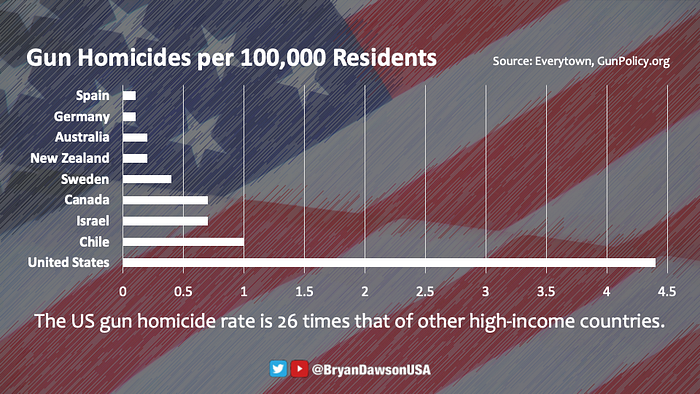
The US gun homicide rate is 26 times that of other high-income countries. Source:[Everytown]
[Everytown] noted that “more than 110 Americans are killed with guns and more than 200 are shot and wounded.” They added: “The U.S. gun homicide rate is 26 times higher than other high-income countries. In 2020, 45,222 people died from gun-related injuries, 54% were suicides (24,292), while 43% were murders (19,384).”
Perhaps the most disturbing [statistic] is that gun violence is now the leading cause of death in children and teens 1–19, exceeding motor vehicle crashes for the first time in 2018.
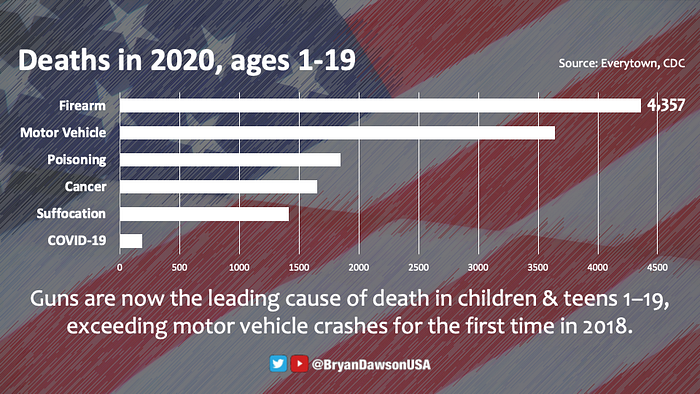
Gun violence is now the leading cause of death in children and teens 1–19
The Breakdown
The bill that made it to President Biden’s desk for signature was far narrower than the one passed by the House. The NRA opposed the it, but sees victory in a bill that does little to close glaring loopholes in our current system. While there are positive aspects, and it does represent welcome progress, the Senate bill fails on multiple levels:
- The bill fails to implement universal background checks and close the gun show or internet sales loophole.
- It doesn’t close the Charleston loophole.
- It doesn’t expand background checks to ammunition or magazines
- It doesn’t address NICS reporting requirements
- It doesn’t require red flag laws
- It doesn’t mandate waiting periods
- It doesn’t address prosecution of felons who fail background checks
- It doesn’t raise the minimum age for buying a rifle to 21
- It doesn’t address domestic terrorism or ban people on the no-fly list
- It doesn’t provide for enforcement and funding for a cash-strapped ATF
- It doesn’t ban any weapons, components, parts, or high-capacity magazines.
- It doesn’t fully close the boyfriend loophole
This bill is what we get when we don’t understand the issues, don’t vote, and believe lies about emails. So, what’s in the bill and how do the various measures rate? Let’s break it down to its components:
1. Mental Health
Background checks are one way to ensure criminals, the mentally ill, and others who could harm others or themselves can’t buy a gun. Since the NICS (National Instant Criminal Background Check System) launched in 1998, the FBI has completed over 300 million checks, leading to over 2 million denials. While millions of prohibited people have been denied a gun purchase, the bill failed to address a system that is deeply flawed and easy to circumvent.
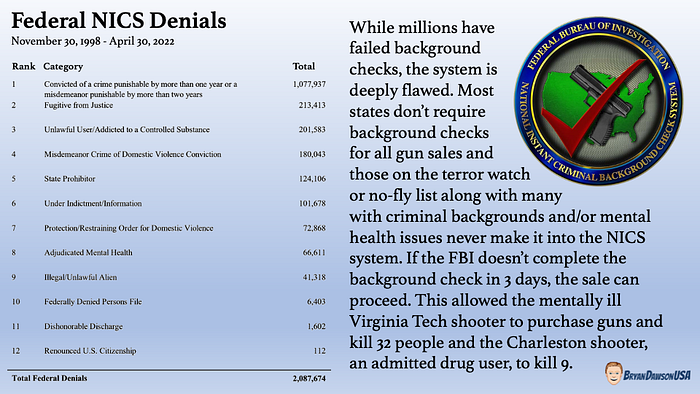
While the information NICS provides is essential to making sure guns stay out of the hands of potentially dangerous individuals, far too many are slipping through the cracks due to missing or incomplete background check records.
“The FBI provides its own records of those who commit federal crimes, but the only way NICS receives records of state-level convictions, mental health adjudications, and other records is through voluntary submissions. As one would expect, some states do a far better job than others sharing this potentially lifesaving information.” — Giffords Law Center
While the FBI submits its records on federal crimes to the NICS, state-level convictions, mental health adjudications, and other related records are submitted voluntarily. Some states are more forthcoming than others in submitting data. That reticence and lack of legal requirements have led to deadly consequences.
One positive aspect to the the bill is that it increases mental health resources. But, Americans are not the only people on Earth who have mental health issues, we are the only people in the developed world with extreme gun violence issues. The [National Alliance for Mental Illness], says the majority of gun violence is not perpetrated by people with a history of mental illness. But access to services is key, so this is a welcome effort.
The bill expands telehealth for mental and behavioral treatment and invests in children and family mental health services through community health centers. So more resources can lead to more counseling which may lead to less violence, and potentially more red flag reporting. This is positive, but I would have liked to see requirements on states to report adjudicated mental health issues. I would have liked to see educational programs for non-mental health professionals, such as teachers and parents to teach people how to recognize warning behaviors. The bill doesn’t require state reporting and fails to address prosecution of felons who fail background checks. I rate this part a 5.
2. Red Flag Laws
Red Flag or “Extreme Risk” laws allow family members, schools, and law enforcement to intervene by petitioning a court for an order to temporarily prevent someone in crisis from accessing guns. But for red flag laws to be effective, various state agencies need to be well-coordinated and the information has to find its way into the NICS.
New York is one of only 19 states with a red flag law. The [Buffalo shooter] made threats at his high school and was taken for a mental health evaluation. Despite the threats, erratic behavior, referral to state police, mental health evaluation, no one tried to invoke the red flag law.
The bill gives money to states to develop and enact red flag laws. The bill overcame Republican objections around due process by giving the accused the right to representation and an in-person hearing at government expense. This has the potential of not only reducing homicides, but gun suicides as well. That’s great, but a lost opportunity to make red flag laws a national requirement I give this part a 5
3. School Security
The bill adds billions for school security upgrades and support for students. This one is hard to argue with since school shootings have been normalized. I give this part a 7.
4. Expanded Background Checks for Under 21
Federal law allows anyone 18 or older to buy rifles and shotguns, including AR-15s, high-capacity magazines, and ammunition for both. Only five states restrict sales of all firearms to 21 or older. Maine, on the other hand, set a minimum age of 18 for handgun sales and 16 for long guns.
Only five states restrict sales of all firearms to 21 or older.
Eighteen to 20-year-olds commit gun homicides at triple the rate of people 21 years and older. Many of these shooters are juvenile offenders. The Parkland, Buffalo, and Uvalde, shooter all bought guns before they turned 21. Science shows the 18-year-old brain has difficulty controlling impulses. My previous article. “It’s the System, Stupid,” addresses this issue.
Rather than raise the age limit to purchase semi-automatic assault-style weapons to 21, the bill expands background checks for people under 21 to include previously blocked juvenile records on criminal activity and mental health and gives law enforcement up to 10 business days to review those records. I give this a 4 — This is a huge lost opportunity. And here’s a kicker — These changes to the background checks system sunset automatically after ten years.
5. Straw Purchases
“86% of handguns recovered by law enforcement agencies were from out of state.” — New York Attorney General’s Office
This bill also addresses Straw Purchases. A “Straw purchase” is where someone buys a weapon on behalf of a prohibited buyer. This is an element in gun-trafficking, where straw purchasers take advantage of the private sale loophole, buying guns out-of-state, and transporting them to areas with stricter gun laws, such as New York or [Chicago].
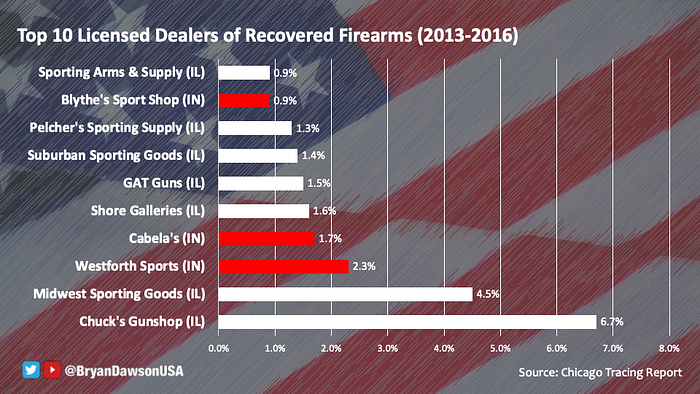
In 2016, the New York Attorney General’s Office commissioned a study on suspected gun trafficking and reported, “86% of handguns recovered by law enforcement agencies were from out of state.” Six out of seven handguns connected to recent crimes in New York state came from out of state. Just as the data on out-of-state guns showed in New York, a 2017 study found that 60% of illegal firearms recovered in Chicago came from out of state, including neighboring Indiana.
Straw Purchases are illegal, but barely. The [NRA fought against the ban] on straw purchases all the way to the Supreme Court where they lost in a narrow 5–4 decision.
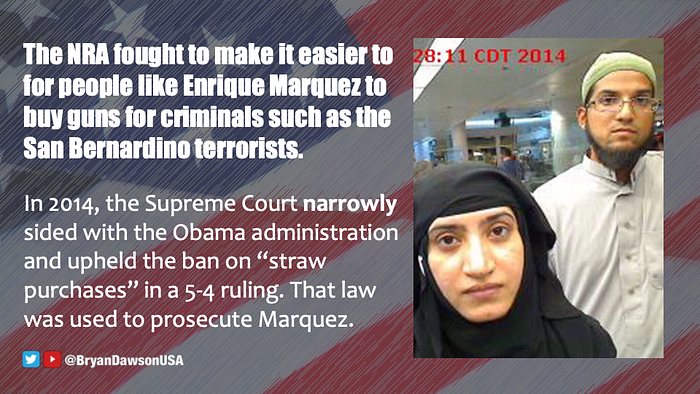
Straw purchases (buying a gun for someone else and circumventing the background check system) are illegal. The NRA fought to overturn a ban on straw purchases and barely lost in the Supreme Court 5–4. The law was used to prosecute the man who bought guns for the San Bernardino terrorists.
A straw purchaser bought the weapons the San Bernardino terrorists used to murder 14 people and injuring 21 more. The gunmen, a husband and wife, were armed with two assault-style weapons and two handguns.
Straw Purchases are hard to enforce, especially in a private sale where there are no background check or paperwork requirements. But law enforcement makes attempts. In 2021, the City of Chicago [filed a lawsuit] against a northern Indiana gun store alleging the dealer ignored the clear signs of so-called straw purchases.
Another issue is the definition of “gun dealer” was too vague. This bill narrows the definition of a federally licensed firearms dealer in an attempt to crack down on those evading licensing requirements and clarifies that an individual who repeatedly buys and sells firearms for profit must register as a Federal Firearm Licensee. It also stiffens penalties for illegal straw purchases. This is good, But I rate it a 5 as it doesn’t address much-needed enforcement nor additional funding for the ATF.
6. The Boyfriend Loophole
Finally, the bill tries to address the “Boyfriend Loophole.” Prior to the bill’s passage, federal law had already prohibited convicted domestic abusers from having guns, but there was a catch: The law only applied to those who had lived with, been married to, or had a child with the victim. It didn’t include abusive dating partners from having guns. Newsflash: Women are as likely to be killed by dating partners as by spouses.
As expected, the NRA fought closing the loophole, citing concerns with “due process.” Imagine: The NRA was lobbying for guys that beat their girlfriends. And I think they see this as a win. Let’s take a look at a few statistics:
- The [share of homicides] committed by dating partners has been increasing for three decades.
- [A study] analyzed mass shootings between 2014–2019 and found in 68% of mass shootings the perpetrator either killed a family member or intimate partner or the shooter had a history of domestic violence
- Gun homicide is a leading cause of maternal death in the US. [Nature reported] on a study by Obstetrics & Gynecology, that “pregnant women in the United States die by homicide more often than they die of pregnancy-related causes — and they’re frequently killed by a partner.”
Negotiations over this piece of the bill held up passage. One point of contention with Republicans was the definition of relationship. The final bill defined a dating relationship as a “relationship between individuals who have or have recently had a continuing serious relationship of a romantic or intimate nature” and applies to anyone convicted of a misdemeanor domestic violence charge. Sounds good, right? Sure, but pay attention to the operative word, “convicted.”
This bill only covers individuals CONVICTED on a misdemeanor charge. The first step in dealing with a domestic abuser is often a restraining or protective order. Anger can run high. If a court issues a restraining order for domestic violence, the abuser can keep his guns.
The bill is also not retroactive. Those with current convictions are not subject to the law. Dating partners convicted of a misdemeanor automatically regain the right to purchase a gun after five years if they were first-time offenders and not found guilty of any other violent misdemeanor or offense. Given these issues, I rate this part a 5.
It’s Not Enough
Overall, I rate the bill as a 5.1. Yes, it’s progress. But, I am deeply disappointed the most glaring holes in the system remain. These holes include Universal Background checks and the gun show and Charleston loopholes. For a deeper analysis, see my article, “It’s the System, Stupid” on the Uvalde and Buffalo shootings.
As a gun owner for gun reform well versed in US gun law, I can tell you our system is nothing short of pure madness. While laws can’t stop all crime (people still run red lights), laws give law enforcement a way to deter, enforce, and prosecute.
There are concrete steps we can take now to reduce gun violence without impacting the right to bear arms and help stop the next mass shooter. The fact that some hailed the Bipartisan Safer Communities Act as the “most significant gun control bill in three decades” is telling. Yes, it takes positive steps forward, but the most glaring holes remain. It’s what we get when we don’t vote and believe lies about emails.
Get armed with reason and fight back.
Recommend
About Joyk
Aggregate valuable and interesting links.
Joyk means Joy of geeK